Generations I-IV: The County of Suffolk, England
What little is known about the three generations of Colburns before Nathaniel the emigrant comes from church records of baptisms and deaths, and the occasional payment of taxes. For generations they lived within a small area in the county of Suffolk, England.
Suffolk comprises roughly the southern half of the ancient kingdom of East Anglia (the northern half is Norfolk; the names derive from "south folk" and "north folk.") The Angles, a pagan Germanic-speaking people, arrived in the fifth century CE, soon after the end of Roman rule in Britain. After alternating periods of independence and domination by the powerful kingdom of Mercia to the west, Anglia was conquered by Vikings from the east.
Some of these raiders decided to stay. As one old Biblical paraphrase put it, “the sons of the Dane saw that the daughters of the Angle were fair; and merry blue eyes and flaxen locks.” The eastern parts of England where they settled permanently after 879 is called the Danelaw.
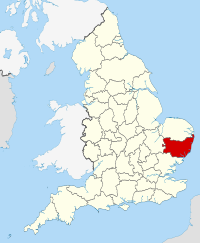
The County of Suffolk, United Kingdom
For protection from later Viking raiders, East Anglia became an earldom within the Kingdom of England after 917. Raiders from the sea continued to be an issue for hundreds of years. According to historian David Hackett Fischer, in his excellent Albion’s Seed, in 1630 at least three towns in eastern England “still had nailed to their church doors the human skins of marauding Danes who had been flayed alive by their intended victims.” Ref
Origins of the Name
Explanations for the origins of the surname Colburn are surprisingly various. According to The Descendants of Isaac Colburn, Jr., of West Dedham, MA:
Some of the Colburns derive the name from ‘cold’ and ‘burn,’ meaning ‘cold brook.’ Others even from ‘coal’ and ‘burn.’ It is found in many spellings, and is sometimes shortened into “Coburn.”
This 28-page privately published history was compiled in the 1920s by Edward Jones Cox, a Colburn descendant whose family branched off from the Otsego County Colburns after the third generation in America. It contains much interesting information, not all of it accurate. It goes on to speculate about a possible derivation from “soldier of the minor Norse god Kol.” No such god appears in standard pantheons.
A village named Colburn exists in North Yorkshire, near a stream by the same name that flows into the river Swale. According to its Wikipedia entry:
The village takes its name from the first settlers along the stream Colburn Beck. It means “cold stream,” a “burn” referring to the valley eroded by the flowing water.
The William Colburn who managed to award his family an official coat of arms in the 1567 was a Yorkshireman. His family name may well derive from this village and stream.
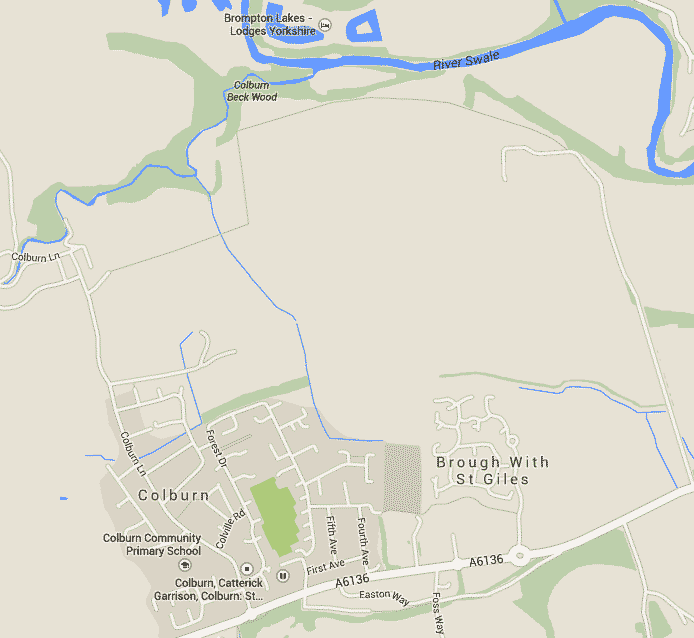
The village of Colburn lies just south of Colburn Beck, a creek running into the river Swale, in North Yorkshire
The emigrant Nathaniel whose descendants are traced here came not from Yorkshire but from Suffolk, a world apart at the time.
Another hypothesis appears in Genealogy of the Descendants of Edward Colburn/Coburn, privately published in 1913.
[Aside from those who may have come from England in recent times, all Colburns in America are descended either from Nathaniel or from this Edward. Edward Colburn emigrated in 1635 on the Defence. A Robert Colburn, likely his older brother, also crossed on that ship, but nothing more is recorded about him. A William Colbron (sometimes Colburn, Colbrand, Colborne), one of the twelve original founders of the Massachusetts Bay Colony, had two daughters and may also have had sons, but little record of them survives.
Although online genealogies often confuse and scramble the early members of these families, Edward seems to have come either from Wiltshire or Cornwall - in either case, almost as far from Suffolk as you can get and still be in England. Nathaniel and Edward are unlikely to have been related.]
The Edward history argues:
There is good reason to believe that the name is not a Saxon but Scandinavian name and that the family came to England with the Danes, that they were sea kings and that the name means either black bear or king’s bear. The bear was a sacred animal with the Danes and has given us a number of names, e. g., Thorburn, Thor being the god of mythology who gave his name to Thursday or Thors Day.... It is possible that it may be a Scotch name meaning Coldstream, a bum being a small brook, or English relating to an occupation, viz: coal burner.
Scandinavian names did become common under the Danelaw period, after 876, particularly in the east and north of England. The family name Colbrand for example derives from the Scandinavian personal name Kolbrandr: dark (kol) sword (brand.) Ref
The spelling "Colburn" only became standard a generation after Nathaniel's arrival. For generations in England his people had been Colborne, Colborn, or Colbron.
"Col" or "Cole" is an ancient Anglo-Saxon name, deriving either from “dark” or old Norse "Kollr," meaning “helmet.” "Cole" appears as a baptismal name in the Domesday Book (a survey William I commissioned soon after conquering England in 1066) and as a family name in the Hundred Rolls, a form of census taken two centuries later. The suffix -borne meant “child of.”
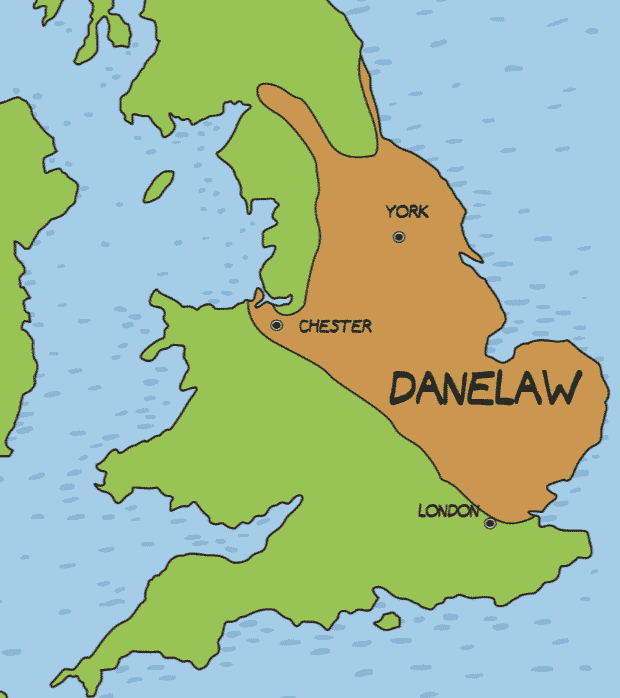
Map of England showing the extent of the Danelaw, circa 900 C.E.
Ref
Thus the simplest explanation for the origin of the name is “child of Cole:” a patronymic, like Johnson or Williamson. Alas for the romantic stories of sea kings, dark swords, cold brooks, black bears, and minor Norse gods!
The Colburn Coat of Arms
Though a "Colburn coat of arms" sometimes appears in family histories, its association with our family is dubious.
In sixteenth century England, as the mercantile professions became lucrative enough to begin to create a middle class, it became fashionable among the nouveaux riche to claim noble descent. Aspiring families invented coats of arms and other accoutrements of nobility, citing highly speculative genealogies as evidence of their long-established rights. The claims to ancient peerage grew so numerous that the bona fide nobility, alarmed by the threat this democratization of title posed to their privileges, empowered a bureaucracy, called the "Herald's College," to decide who had legitimate claims and who did not.
Among the functionaries of the Herald's College, tasked with legitimizing or debunking claims to peerage, was one William Colburn. Just before he died, in 1567, after a career debunking spurious claims to peerage, William took advantage of his position to assign a coat of arms to his own family. To William we owe the coat of arms of the ancient and honorable Colburns.
William came from York. During his lifetime the family chronicled here, known to their neighbors as the Colbornes, farmed in relative obscurity far to the south, in Suffolk.
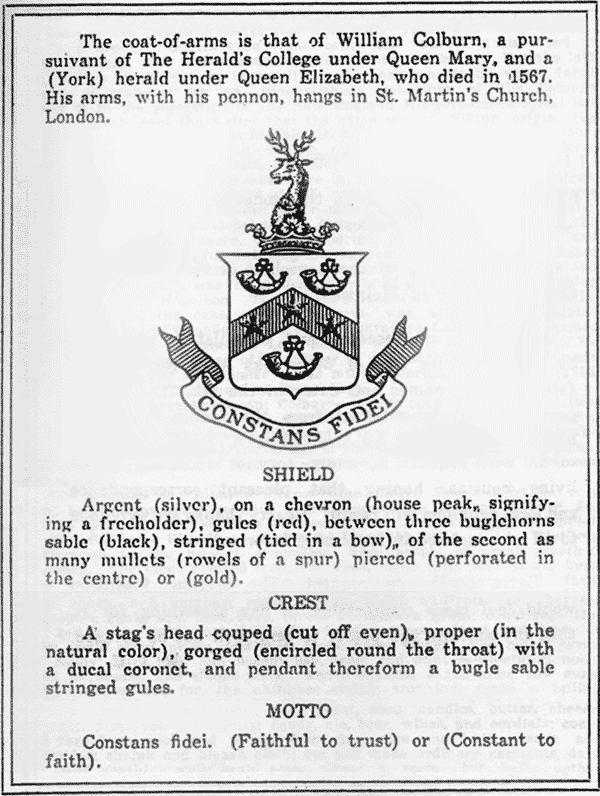
Coat of arms of William Colburn, Esq., as displayed in one family history. Unlike many coats of arms available for purchase on the Internet, this one is genuine, appearing in various books of heraldry. William however was probably not related to the Colbornes chronicled here. Ref
Generation I: John? Colborn (or Colbron) 1490
Two years before Columbus stumbled upon the New World, one year before the birth of the future King Henry VIII, a male child was born, somewhere in the Cosford Hundred.
A “Hundred” is a traditional Germanic geographical term, first recorded by Tacitus in 98 CE. It may originally have meant an area with a hundred households, or a small (roughly, hundredth) part of a larger territory, or a place large enough to be able to recruit a hundred soldiers from the male inhabitants. Now called "Districts," the ancient Hundreds still form the structure for local government throughout much of England.

Western Suffolk Hundreds in 1830. Colborns lived first in Cosford then Samford.
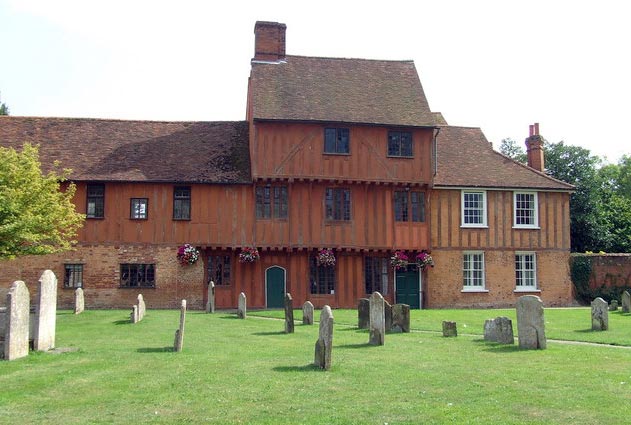
14th-century Guildhall, Hadleigh, Suffolk Ref
The Cosford Hundred comprised a dozen hamlets and one major town, Hadleigh. Guthrum, Danish king of East Anglia, is supposedly buried in Hadleigh.
That a Colborne lived in the area is chiefly known because he had to pay taxes. From time to time the King would ask Parliament to grant a “lay subsidy“ on goods, crops or wages (clergy were exempt.) Parliament granted one to Henry VIII in 1524, and a Colborne paid his share.
The first name of taxpayer Colborn was not recorded. About the same time however ‘John Colborn” appears on a list of business transactions in a place called Glemham Magnus (now Great Glemham), on the other (eastern) side of Ipswich.
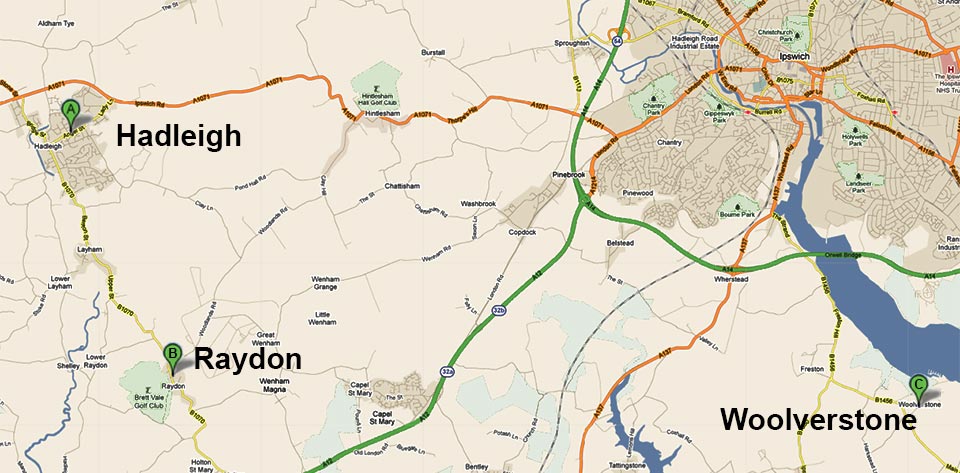
Part of Suffolk, west and south of Ispwich, the county seat.
A: The first two known generations of "Colborns" lived near the town of Hadleigh, in the Cosford Hundred.
B: Edmund Colbron, born circa 1544, lived in Raydon, 3 miles south of Hadleigh in the Samford Hundred.
C: Leonard Colborne, born circa 1571 in Raydon, died in Woolverstone, 10 miles to the east.
Generation II: John? Colbron c. 1510
The first name of the second generation is also uncertain, but also perhaps John. He was born circa 1510. The name of his wife is also not known, but the names and baptismal years of their children are.
JOHN COLBORN
born circa 1510
married ?
children
Mirable circa 1530
Robert circa 1533
John circa 1636
EDMUND circa 1545
Generation III: Edmund Colbron c. 1545
Edmund (or Edmond) was born circa 1545, probably in or near Hadleigh. This was ten years before the birth of William Shakespeare (and about 150 miles to the east of Stratford-on-Avon.)
On 27 January 1569 he married “Ellyn Colman widdow” in Raydon, a few miles south of Hadleigh.
They had one child, LEONARD.
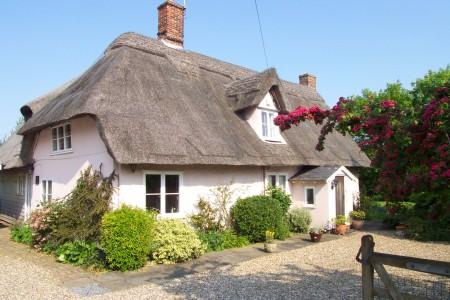
An old thatched-roof house in Raydon, Suffolk, in 2014.
Generation IV: Leonard Colborne (also Colberand)
Leonard was baptized 15 Mar 1571 in Raydon, Suffolk. Babies then were always baptized within a year of birth, so he was born either in 1570 or 1571. Elizabeth I had been queen for about twelve years. On August 24 1601, he married Sarah Lewes in her home town of Woolverstone, to the east of Raydon along the banks of the Orwell south of Ipswich. They were both 30 years old. They had five children:
LEONARD COLBORN
baptized Mar 15, 1571
married Sarah Lewes, August 24, 1601
children
John Baptized May 9, 1602
Thomas Baptized Mar 18, 1603/1604
Sarah Baptized 8 Apr 1606. Died in Woolverstone, June 1674, aged 68.
Samuel Baptized May 10, 1608
NATHANIEL Baptized Sept 12, 1611
buried Jul 15, 1647, Woolverstone
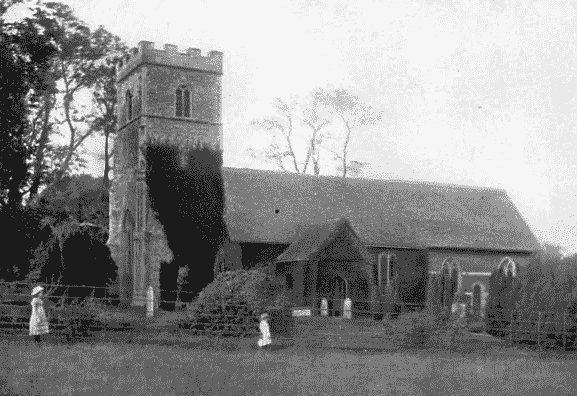
St. Michael’s Church in Woolverstone circa 1895. Nathaniel Colburn was baptized here in 1611.
Though the church has been remodeled several times, parts still date to the 1300s.
An 1898 book about the minister who baptized Nathaniel paints this picture of his hometown:
Woolverstone, originally Woluestun, is described as a pleasant village and a fertile parish on the southwestern bank of the Orwell, four miles distant from the busy market-town and seaport of Ancient Ipswich. It belongs to Samford hundred and deanery, in the archdeaconry of Suffolk and diocese of Norwich... ...The spreading Orwell, with its wood-clad sides, is really an estuary extending ten or twelve miles from the sea to the town of Ipswich... ...At Ipswich it meets the river Gipping, from the heart of the county. The estuary has long been celebrated for the beauty of its scenery. To one Englishman it suggested our own Hudson. Ref
For many years there was no proof that the Nathaniel Colburn who joined the Puritan Great Migration to Massachusetts in the 1630s was the one born in Woolverstone. Some online genealogies still claim that he was born in Bedfordshire, and others that he was the son of the William Colburn who helped found the Massachusetts Bay Colony. In 1999, however, a descendant of relatives of the woman he later married (Priscilla Clarke) published an article resolving the issue:
Unfortunately, no will was located for Leonard Colborn that might have confirmed that his son Nathaniel was the New England immigrant. However, in her will, written 13 March 1672 and proved 4 june 1674, ‘Sarah Colborn of Woolverstone ...spinst(er)’ bequeathed
‘...my house & tenam(en)t with ye ground and all yt pertains to it...lyeing in Woolverstone ... unto my loving brother Nathaniel Colborn liveing now in Dedha(m) in New England to be enjoyed by him for ever.’
The English origins of Nathaniel Colborn, the son of Leonard and Sarah (Lewes) Colborn of Woolverstone, have been clearly established. Ref
We have only the barest of facts for the generations chronicled so far. Once Nathaniel the Puritan departs for Massachusetts, the story gets much more interesting.